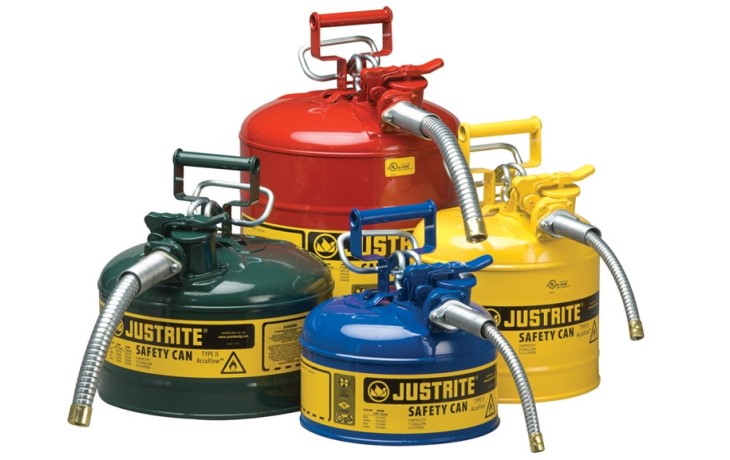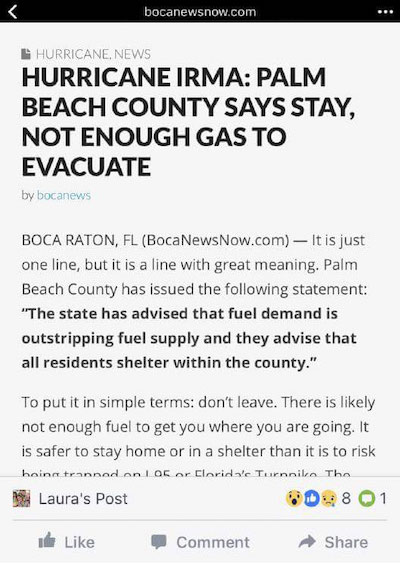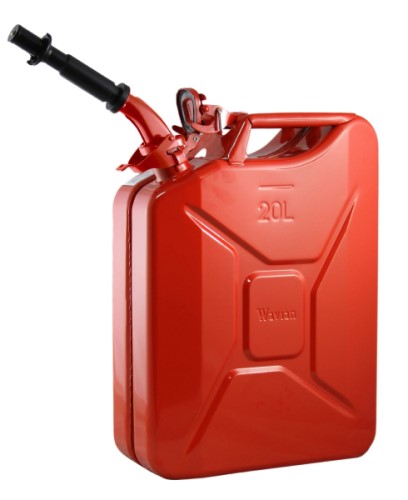Having a ready supply of fuel is a good prep. This review covers fuel cans that can be safely stored in an outbuilding or garage for the long term.
Five-gallon metal cans are the best solution for most people. They’re small enough to carry and easily store but large enough to hold a sufficient amount of gas. You can buy several and use a sticky note or a piece of tape to write down the date the fuel was purchased.
The most important bits:
- Experts recommend storing enough gas to fill your main vehicle, which is roughly 15-20 gallons. If you have a generator, keep enough fuel on hand to fill it at least once.
- Common fuel cans are available 1, 2.5, or 5 gallon sizes.
- Fuel cans are typically metal or plastic, and are color coded for specific fuel types. Red is Gasoline, Blue is Kerosene, Yellow is Diesel, and Green is oil.
- Metal safety fuel cans are available in two variants, Type 1 or Type 2. Type 1 cans fill and dispense fuel from the same opening. Type 2 cans have an extra spout which can act as a vent, making them easier to pour.
- For long-term fuel storage, metal cans are better than plastic. Plastic chemicals can leach into fuel, and plastic will degrade over time. Metal can rust, but in general will last longer than plastic.
- Check local and state laws about fuel storage. Some areas have stringent regulations about what types, how much, and where can it be stored.
- The best place to store fuel is in a well-ventilated shed or garage. Keep your fuel containers away from potential ignition sources.
More: How to store gas at home (and does gas go bad?)
After 10 hours of research, including reviewing 20+ products, these are top choices to help shortcut your shopping. We stuck to US Department of Transportation and Occupational Safety and Health Administration guidelines for our recommendations, so you can feel confident buying the safest possible cans for fuel storage.
The top picks are durable metal cans that self-vent to relieve pressure build up. Unlike plastic cans currently on the market, which are hampered by Environmental Protection Agency regulations, our picks are easy to pour, won’t belch gas everywhere, and won’t implode or balloon up.
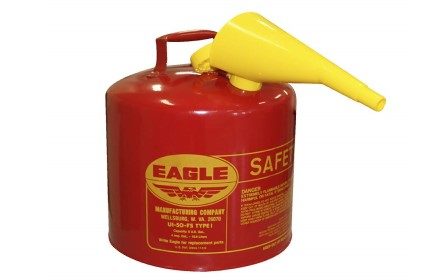
Eagle 5 Gallon Type 1 Steel Safety Can
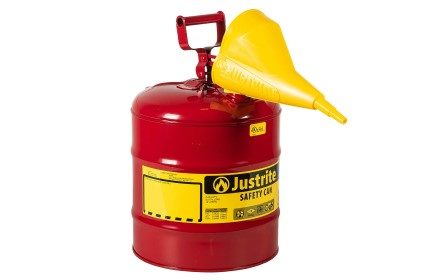
Justrite 5 Gallon Type 1 Steel Safety Can
Metal fuel cans:
- Eagle Type I 5-Gallon Diesel Can and Gasoline Can
- Eagle Type II 5-Gallon Diesel Can and Gasoline Can
- Justrite Type I 5-Gallon Diesel Can and Gasoline Can
- Justrite Type II 5-Gallon Diesel Can and Gasoline Can and Kersosene Can
Plastic fuel cans:
- DuraMax Flo n’ Go 14 gallon rolling Gas Can
- No Spill 5 Gallon Diesel Can and Gas Can
- Scepter Smart Control 5 Gallon Diesel Can and Gas Can and Kerosene Can
- Scepter Smart Control 5 Gallon Diesel Can and Gas Can with Rear Handle (an easier-to-use upgrade over the base model)
- SureCan Easy Pour 5 Gallon Diesel Can and Gas Can
Be prepared. Don’t be a victim.
Want more great content and giveaways? Sign up for The Prepared’s free newsletter and get the best prepping content straight to your inbox. 1-2 emails a month, 0% spam.
What about Jerry cans?
Jerry cans, like the Wavian USA fuel can, are excellent fuel canisters. They’re well built, carry a lot of fuel, and are great if you have to jump in a vehicle and evacuate a location.
Although they’re popular among preppers and we have a few ourselves, the reason cans like the Wavian aren’t the main recommendation is because they are vapor-tight, meaning they will not vent and pressure can build up over long-term storage.
If you do end up with this style, try to get in the habit of manually venting the can once in a while, maybe as part of your annual preparedness review.
Wavian Jerry can. Great for temporary fuel storage, especially for vehicles. Not necessarily the best option for long-term storage.
Plastic vs. metal fuel cans
Fuel cans are made of either plastic or metal. Metal cans are heavier and more expensive, and last longer. Plastic cans are cheaper and lighter, but can break down over time and leach chemicals into your fuel. For long-term fuel storage, metal cans are better if you can afford them. Not only are they more durable, but the regulations around them are more reasonable than plastic cans, as we’ll explain later.
Tip: Never store gasoline or diesel fuel in your house, but rather in a ventilated garage or outbuilding. Always keep a fire extinguisher by the door wherever you store your fuel.
More: Best fire extinguisher for your home and vehicle
Fuel can size
Most gas cans in the American market come in roughly 1-, 2.5-, or 5-gallon sizes. There are some oddball sizes like 2.2 gallon, so take that with a grain of salt. We recommend investing in 5-gallon cans for maximum optionality. Since gasoline weighs about six pounds per gallon, five gallons of gas is 30 pounds. If you struggle to lift that much, just put less gas in the can, or look at a larger can that is equipped with wheels.
There are larger sizes available, but five gallons is about all most people can reasonably lift and tip. Beyond that, you’d probably want some sort of a pump to fill your engines. There are also good safety reasons to limit containers to five gallons, which is why OSHA limits portable fuel containers to that size.
Understanding fuel can colors
Fuel cans are color coded based upon the type of fuel they store:
- Red: Gasoline
- Blue: Kerosene
- Yellow: Diesel
- Green: Oils
It’s important to store fuels in the appropriate color-coded container so they don’t get mixed up. You don’t want to put kerosene in your car by accident, nor do you want to mix diesel and gasoline. In a pinch, is it safe to put diesel in a clean gasoline can and vice versa? Yes.
Tip: Don’t store water in a metal fuel can. It will break down the inner lining and cause rusting, which will decrease the life of your fuel can.
Type I vs Type II cans
There are two types of safety cans. Type I cans have only one opening for filling and pouring and usually need a funnel for filling. Here’s a video showing how Type I cans work:
Type II cans have an opening for filling and another for pouring and they usually have an attached spout. Here’s a video showing how they work:
Type II cans tend to be twice as expensive as Type I cans. We don’t think the Type II cans are worth it for most people. As demonstrated in this YouTube video, if you combine a funnel attached to a Type I can with another funnel in your vehicle, you get a perfect, mess-free pour.
Like the EPA-approved cans, safety cans don’t pour freely, but their opening mechanisms aren’t flimsy plastic buttons. Instead, they have big pull handles. Metal gas cans won’t collapse or balloon up like plastic ones, either.
Fuel safety standards and the dreaded EPA nozzles
Over the past few years you might have noticed that gas cans look different than they used to. Instead of just plain red cans with a flip-top vent and a simple hose nozzle, they have all sorts of spring-loaded contraptions for dispensing gas. Some work better than others, but many people hate them.
You can blame or thank EPA regulations for that. Since 2009, gas can makers have been required to have only one automatically closing opening for both filling and venting. Instead of pouring freely, they usually require either pushing a notch against the rim of the fill hole and pushing it in or pressing a trigger.
The idea is to prevent gas fumes from leaking into the atmosphere, but many people have trouble using them and end up spilling more gas than they did with the old designs. Since there isn’t a rear vent to open and promote airflow, these cans can “burp” out gas, causing spills. Again, some work better than others.
However, there are a couple of bits of good news. E-Z Pour makes replacement spouts and add-on vents for your plastic gas cans.
Decades before the EPA stuck its nose in the gas can business, the Department of Transportation had its own standards, which OSHA mirrors. These are sold as “safety cans,” and must meet the following criteria:
- Be made of metal
- Hold five gallons of fuel or less
- Feature a spring-closing lid and spout cover
- Have a means to relieve internal pressure to prevent explosion (venting)
- Include a flash-arresting screen
These specifications minimize fires and explosions.
